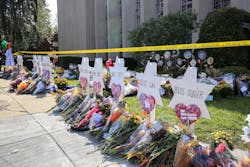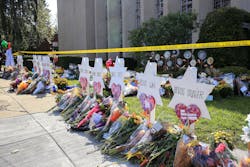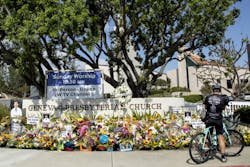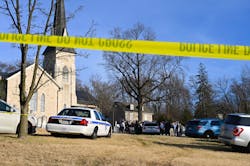Is There A Place for Weapons Detection Systems in Houses of Worship?
During Sunday services on May 15, 2022, a 68-year-old man named David Chou entered the Geneva Presbyterian Church in Laguna Beach, California, which was hosting members of the Irvine Taiwanese Presbyterian Church. Chou bid his time until the post-services luncheon when he pulled out a gun and started firing at churchgoers. He killed one person and wounded five more. Authorities determined that he was motivated by his hatred for Taiwan and the Taiwanese people.
Only a few weeks later, a gathering of senior citizens at an Episcopal church in Alabama for a 'Boomers Potluck' dinner was disrupted when Robert Findlay Smith, a 70-year-old parishioner, opened fire on other attendees. Two women and one man from the congregation perished.
Religious institutions are no stranger to violence. No house of worship (HOW) has been spared attacks–not mosques, synagogues, churches, temples, or meetinghouses.
There have been at least nine attacks at U.S. synagogues since 2018. A December 2022 report from the Family Research Council documents 12 gun-related incidents in churches from 2018 to 2022. The November 2017 attack on a rural Texas Baptist church that killed 26 parishioners is regarded as the most lethal attack ever on a U.S. HOW.
In Europe, many Jewish HOWs have been hardened to include gates, guards, and metal detectors. Some churches and mosques have followed suit.
Yet very few religious facilities in the United States use weapons detection systems (WDSs), be they sophisticated systems combining metal detection, cameras, LIDAR and AI at one end of the spectrum or simple magnetometers or metal detectors at the other end.
Attacks on HOWs persist. Should WDSs have a place in religious institutions?The Case for WDSs
If adversaries can use any tool in their arsenal, why shouldn’t houses of worship? As former Detroit and Dearborn, Michigan Chief of Police Ronald Haddad puts it, “The unfortunate reality in 2023 is that places of worship remain at the top of the list as soft targets for acts of terror and targeted violence. Accordingly, each place of worship has the responsibility to take all reasonable measures to protect their congregations. This includes alarms, video, weapon detection technologies and security personnel.”
No single security approach or tool is a magic bullet of course, and any security program should arise from the results of a thorough risk assessment. If an assessment shows a considerable risk of an armed attack at a religious institution, a WDS could be part of the solution.
While some say that WDSs are going too far, others insist that they are just another tool and that there is nothing fundamentally different about them. Over the past decade, HOWs have slowly but consistently added cameras, armed officers, access control systems, alarms, emergency notification systems, policies and procedures, panic buttons, intercoms, emergency plans, active assailant training, and many other elements of sound security programs. Why are WDSs off-limits?
“New security technology can be very beneficial as well as cost-effective,” says Kurt Jordan, a Florida-based national safety security deputy with the Christian Emergency Network (CEN). “There are advanced systems that detect firearms effectively,” he adds, mentioning robust technology that combines cameras, metal detection, object recognition, and AI.
In addition, the costs of a system may be covered, at least in part, by millions of dollars in federal grants made available annually to HOWs.
Some experts say that WDSs can be a valuable investment if they not only are merited by the risk but also fit into the culture of the facility and community. Dan Graeber, VP of Faith-Based Relations for the Center for Personal Protection and Safety in Spokane, Washington, notes that “Weapons detection overall is acceptable in many church cultures… There are some modern detection systems that work very well if you have the appropriate technology in place at all access and egress locations.” He singles out camera-based systems as effective tools since they are discreet and don’t require attendees to pass through a detector.
For facilities with adequate space, WDSs can leverage mantraps. Mike Marshall, COO of Covenant Security Equipment, suggests staging WDSs in vestibules, which consist of a small area at the entrance to a building enclosed by bullet-resistant windows and doors, and providing proper training to staff or contractors. “This approach allows trained individuals to monitor and assess potential threats at the entrance, creating a safer environment while maintaining the welcoming atmosphere of religious spaces,” Marshall says.Some of the strongest arguments in favor of WDSs in religious facilities come from churches that have actually installed them. A head of security for one such church (who asked that his institution not be identified) credits magnetometers with keeping violence out of the holy building. The church is located in an urban environment frequented by the homeless, mentally unstable, and transient. He says that security has found at least one large knife outside the church that was likely abandoned when the owner saw that the church screens for weapons.
This urban church hasn’t faced some of the disadvantages of WDSs that are articulated later in this article. For example, the security director says that the cost is manageable, including the hiring of multiple officers to operate the system, such as one with a wand magnetometer to follow up on someone who triggers an alarm. And training on the system was simple, he says.
Moreover, the equipment has not caused delays, backups, or complaints. The system usually picks up items such as nail clippers, pen knives, and box cutters. Security temporarily confiscates each item and places it in an individual evidence bag. Items are returned when the person leaves.
The security director emphasized that visitors and congregants aren’t treated like concertgoers or sports fans entering a stadium or other venue. “We do this with dignity,” he says. And staff and parishioners alike say they feel safer.
For institutions that are adamant about adding the technology, “The way the issue is presented is key,” says Bob Howard, Director of Emergency Management for the city of Sandpoint, Idaho. “It may be best accomplished by presenting it as a way for protecting kids, first of all, then spouses and elderly members.” If a house of worship conducts a security questionnaire of its congregants and solicits ideas, Howard says, “You might get buy-in for the detectors at that point.”
The Case Against WDSs
“The day U.S. religious institutions regularly install metal detectors is the day when worship in this country is changed irrevocably,” says Paul Goldenberg, the Founder of the Secure Community Network (SCN; the nation’s first full-time faith-based threat and information-sharing center) and former Vice Chair of the U.S. Department of Homeland Security’s Faith-Based Advisory Security Council. “These institutions were built for openness and inclusion.”
As chief of the first statewide office in the United States committed to the investigation of hate crimes and domestic terrorism, Goldenberg has investigated hundreds of faith-based crimes and attacks on religious institutions, including the toppling of gravestones a few feet from where his own father is buried. Yet he doesn’t consider WDSs to be a viable option.
Mark Genatempo, a house-of-worship security expert and Goldenberg’s colleague at Rutgers University’s Miller Center for Community Protection and Resilience agrees. “I believe we would lose something intrinsic to the ‘freedom of religion’ aspect of our society that we could never get back, making our houses of worship into fortified institutions.”
Other common objections, besides disturbing the sanctity of the environment, include intimidating worshipers, who will stay away. “I think it may cause attendance to shrink, only because there could be a perception of ‘no trust,’ explains Sandpoint’s Director of Emergency Management Bob Howard.
The main detection technologies present their own issues, says Jeff Slotnick, President of the security firm Setracon and one of the co-founders of SAFE Washington, a security and intelligence partnership led by the Jewish Federation of Greater Seattle. Magnetometers are often triggered by harmless objects like belt buckles and require at least one secondary screener to do a follow-up wand scan. During major holidays or large events, the HOW might need multiple portals and screener teams. Otherwise, the crowd will create backups at the front doors, which facilitates attack opportunities.
“Metal detectors don’t catch ceramic weapons,” adds Paul Wade, a security trainer for the CEN and a former officer with the Orange County (CA) Police Department. “I think these machines also lead to a false sense of security.”
Manufacturers of other types of WDSs, such as radar/millimeter-wave, thermal, and visual-based, especially when the devices incorporate AI, say they can detect nontraditional weapons. But there have been reports of such systems missing knives, bombs, and other types of weapons.
Genatempo, of the Miller Center at Rutgers University, adds that WDSs won’t stop a determined adversary. “They’d simply go in through one of the many doors propped open or unlocked,” he says. “Or just approach the magnetometer, draw a weapon and start shooting right there.” At best, he contends, the “attacker would simply go to a softer house of worship down the block.”
But for a community protecting its flock, displacement may well be better than the alternative.
WDSs also require significant funding to purchase, install, operate, and maintain, including operational expertise and management that most HOWs can’t resource. Genatempo says that while there may be a place for WDSs at special events in HOWs, everyday use is simply not sustainable for most institutions.
Another argument against WDSs is that religious facilities will rely on the systems as a panacea or full-blown security program—hence Wade’s comment about lending a false sense of security. Critics also say that when someone actually enters with a gun, religious institutions won’t be equipped to respond.
“It’s a double-edged sword,” admits Jason Lindley, a former Arizona State Police Officer and advisor to CEN who has trained church security teams. “You’ll have people that want them and will make them feel more at ease. Others will be anxious by having them there.”
One consequence of WDSs is that legally carrying congregants will have to leave their guns behind. “If I’m a criminal, I want to do my activity where I know it’s a gun- or weapon-free area,” Phoenix’s Lindley says. “I’d be able to inflict a lot more damage because I would be met with little to no resistance.
In many parts of the country, the right to carry a gun is cherished as much as the right to free exercise of religion. Gun owners may switch congregations if their weapons are banned. And even if they stay with their HOW and leave their guns at home, they won’t be able to defend against an active shooter unless they have an arrangement with the staff and clergy to carry their weapons. That causes its own issues, such as who gets selected for that role.
Other Approaches
Several experts contacted for this article offer alternatives to WDSs. Some suggest welcoming weapons—legally carried and owned by members of the congregation—rather than barring them.
Daryl Kramer, a CEN affiliate member and former private sector coordinator for the Department of Homeland Security’s Office of Intelligence and Analysis, advocates leveraging the trained, certified gun-carrying members in the congregation. “Have churchgoers get certified for open carry and allow them in,” he advises. “More armed and trained security responders in churches mean less chance that an active shooter can kill.”
Some houses of worship adopt a sort of “Don’t ask, don’t tell policy.” Lest they get a reputation as an easy target, these facilities don’t ban guns. Nor do they explicitly welcome them. They rely on some members of the congregation who are known or assumed to carry guns to respond to an assailant.
Many experts emphasize human intelligence and observation over physical systems, recommending that HOWs train greeters, ushers, and other staff on nonverbal behaviors. “The bad guys will always give clues as to their intentions,” says Michael Boler, a consultant with CEN with expertise in racial reconciliation and training the underserved in Indianapolis. “The problem is we lose focus or just don’t know what to look for.” Boler’s solution? “Spend money on training greeters and be creative with suspicious behavior recognition.”
SAFE Washington’s Slotnick and the Miller Center’s Goldenberg offer similar advice. During high-threat times, congregations can perform the same function as a WDS with far less cost: “Good policies and procedures, such as banning backpacks, supplemented by a physical screening and visual search,” advises Slotnick.
Technology is far from anathema, however. Goldenberg says that tools such as panic alarms can be critical components of a holistic security posture.
And WDSs may well have a place. “Although weapons detection technologies can be valuable security tools, it’s important that any specific solutions be evaluated and implemented as part of a comprehensive security plan that combines people, training, policies, equipment, and other resources,” says Robert Graves, regional security advisor to SCN’s National Capital Region. “Organizations and facilities vary widely in their needs and priorities. There is no one-size-fits-all solution for security.”
Dickson Skipper, former head of security for the Billy Graham Association, recommends pairing trained greeters with uniformed off-duty police officers. Skipper says: “A marked police car prominently placed in front or in the parking lot also provides a good deterrent.”
At bottom, the decision on whether to use WDSs comes down to the results of a risk assessment and the culture of the facility. As Skipper puts it, “Churches are one of the most difficult places to protect because they are meant to be open and provide a friendly welcome. What I tell folks is, ‘What do you consider an acceptable risk?’ You can’t have your church operate like a prison.”
About the authors:About the Author
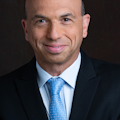
Michael Gips, JD, CPP, CSyP, CAE
Contributing writer at Swiftlane
Michael Gips, JD, CPP, CSyP, CAE has written almost 1,000 articles and columns on virtually every topic in security. He is currently the Managing Director of ESRM for Kroll and the principal of Global Insights in Professional Security, LLC. This firm helps security providers develop cutting-edge content, assert thought leadership, and heighten brand awareness in a crowded marketplace. He has been repeatedly named as one of the most influential thought leaders in private security. He recently joined the Board of Advisors of Draganfly.
Gips is an occasional contributor to SecurityInfoWatch.com and Security Executive magazine.

Mary Marr
Founder and President of the Christian Emergency Network
Mary Marr is the Founder and President of the Christian Emergency Network, a network of professional emergency and security consultants that helps safeguard churches. She served for twenty years as the Co-Chair of the Department of Homeland Security’s Faith-Based Security Advisory Committee.
